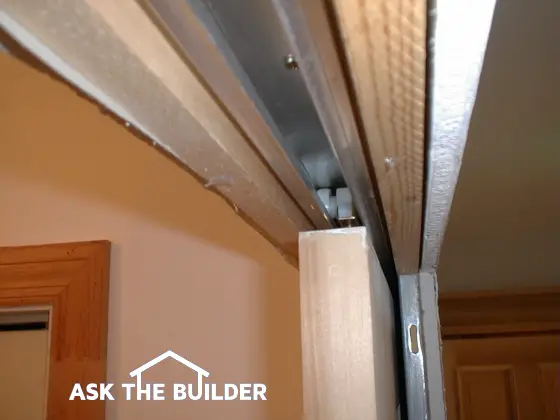Fixing a Pocket Door

This is the track of a modern pocket door. The finish jambs have not been installed and I can both adjust the door and actually remove the door from the wheeled trolleys. When I do install the finish jambs, they will be screwed into the rough jambs with decorative screws that are flush with the surface of the wood. This way I can easily remove the finish jambs should I have to work on the door.
DEAR TIM: I have a troublesome pocket door between my master bedroom and the master bath. The door constantly jumps off the single rail track. I am convinced I need to install new hardware to permanently solve the problem. What is the best hardware to use and is there an easy way to complete the repair? Jorge F., Chula Vista, CA
DEAR JORGE: I must tell you that I love pocket doors but only ones that work smoothly. As you might expect, I have had to troubleshoot more than my fair share of minimum quality pocket door rollers and tracks that give homeowners problems on a routine basis. Twisted doors, settlement issues, poor initial installation, etc. can cause pocket doors to become problem doors. The good news is that you should be able to quickly replace several parts or install a new pocket door frame kit. Choose wisely and your door will be trouble free from now on.
Purchasing a new pocket door frame and track is relatively easy. Most traditional lumber yards that sell doors can supply you with a top quality kit. You are looking for a frame that has a one piece box shaped track system that has two J shaped tracks that face each other. This track accepts two tricycle type roller trucks that attach to the top of the door. Once the three wheeled trucks are placed in the track and the door is connected to these truck assemblies, it is impossible for the door to jump from the track. The design is simply brilliant. I have installed many of these and even have one in my own home. The doors glide back and forth as smoothly as I swing in my hammock on a lazy summer afternoon.
Just so you know, getting the parts is the easy part of the job. Performing the surgery to replace the old frame can be tricky. The difficulty of the task depends upon the wall treatment on each side of the pocket door. If the surfaces are wallpapered, then be prepared for misery. If the surfaces are painted drywall, it is entirely possible that the walls and door can be restored to as good as new in as little as 48 hours.
Removal of the trim casing around the door is the first step you must do to remove the pocket door. If you take your time using wide pry bars, you can often salvage this trim. The jamb material that covers the rough framing is the next thing to remove. At this point you have completely exposed half of the track. If you determine that the width and height of the new track match the existing one, you are in fantastic shape. Your challenge now is to gain access to the hidden part of the track.
The metal pocket door track typically is connected to a wooden frame member with screws. Remove the door from the pocket and take it off the track. Use a flashlight and peer up into the pocket cavity. There is a good chance you will see the screws that fasten the track to the frame. It is now time to cut an access hole on one side of the pocket wall. This hole will allow you to get your hand or arm into the pocket so that you can loosen and remove the screws and subsequently the track.
Once the track is removed, you simply cut the new track to the appropriate length and install it in place of the old one. Keep in mind that the track does not touch the rough jamb at the open end of the frame. There has to be sufficient space between the track and the jamb to insert the tricycle roller trucks. Be sure that the new track is level. The new rollers and track are so well engineered that an out of level track can cause the door to open and close on its own.
If your new track does not match the old one in width and height, the job becomes more difficult. You will most likely have to tear out the old frame and install a new one from scratch. This sounds harder than it is. Believe it or not, I have completely removed the drywall from both sides, demolished the old pocket door frame and installed a new pocket door frame including new drywall in as little as two hours. Purchase some dry setting type joint compound that sets in 30 minutes and you can actually be ready to paint the new drywall in as little as four hours.
Column 405